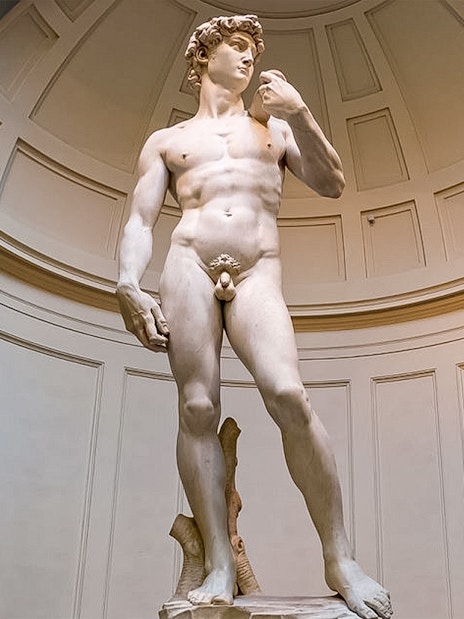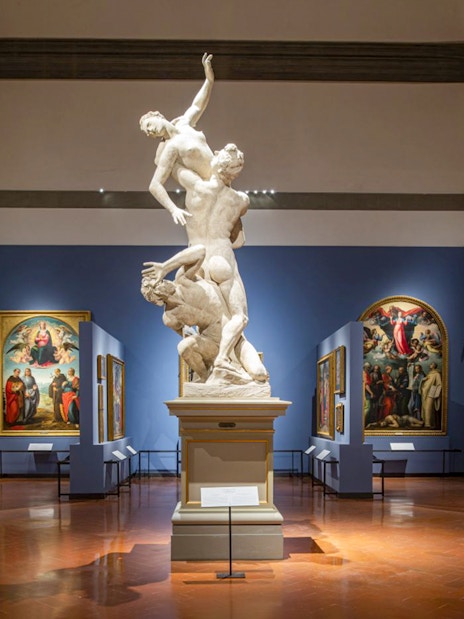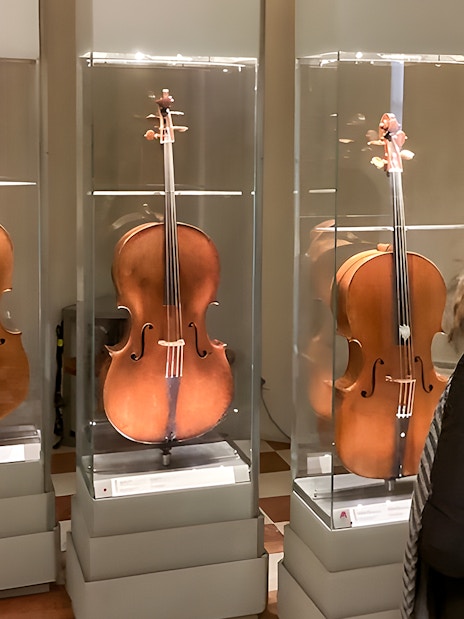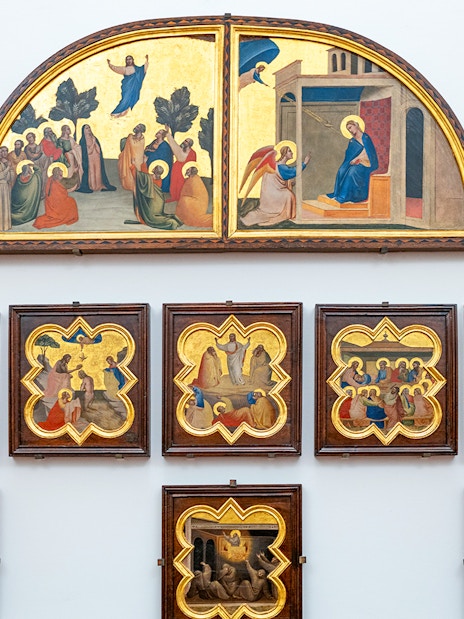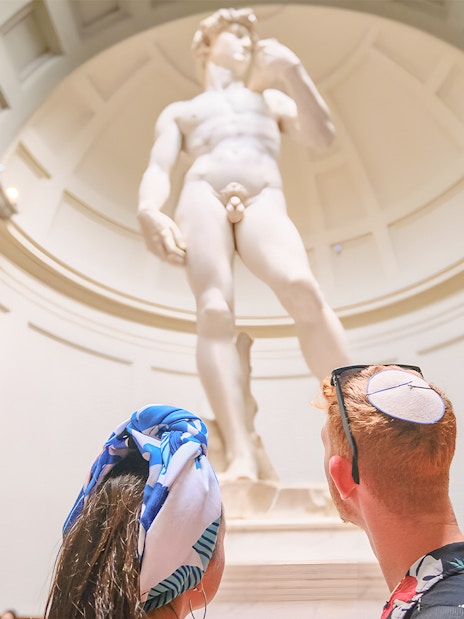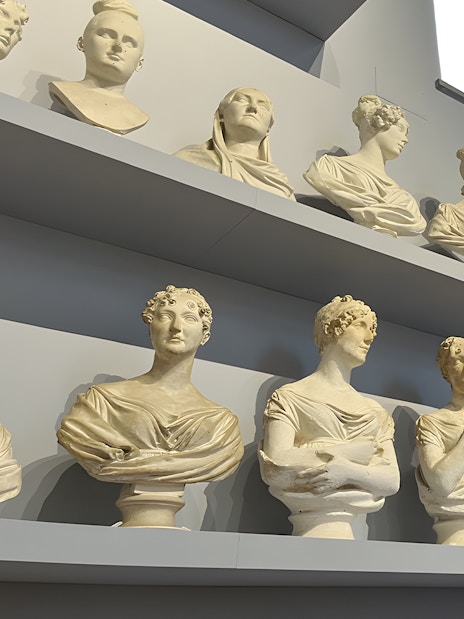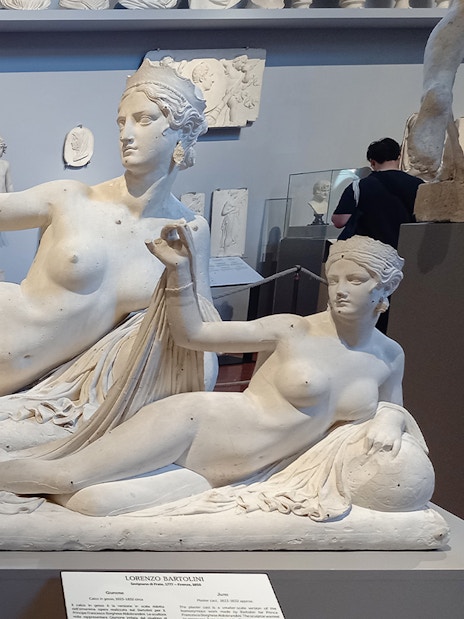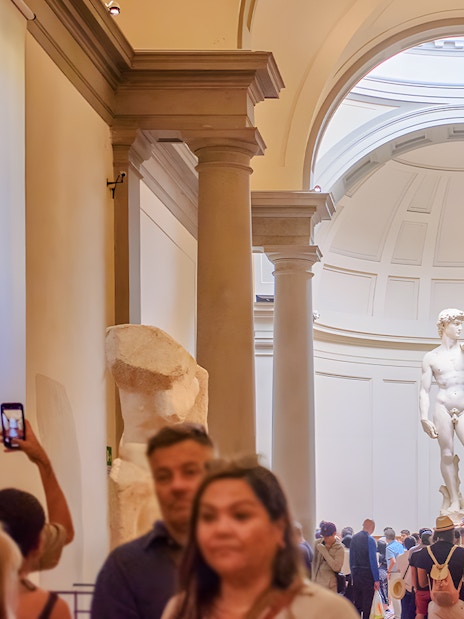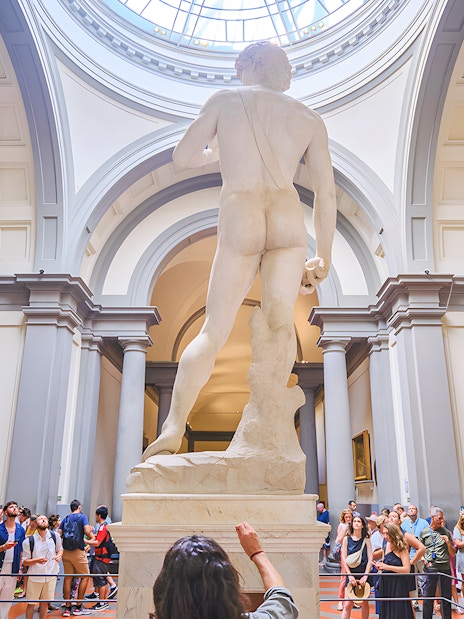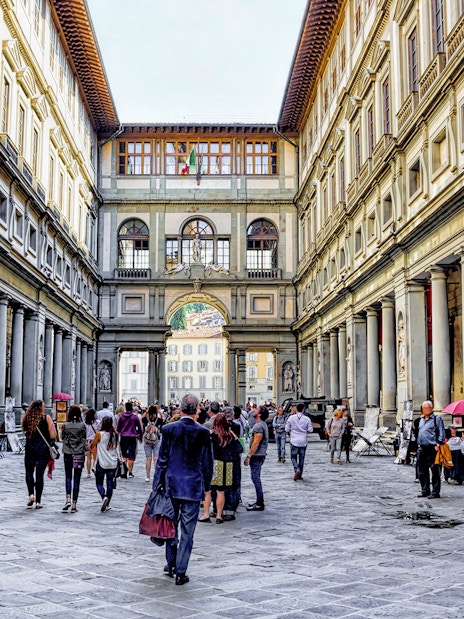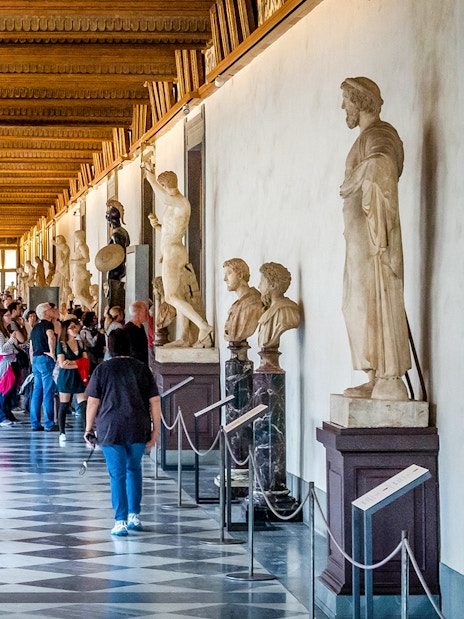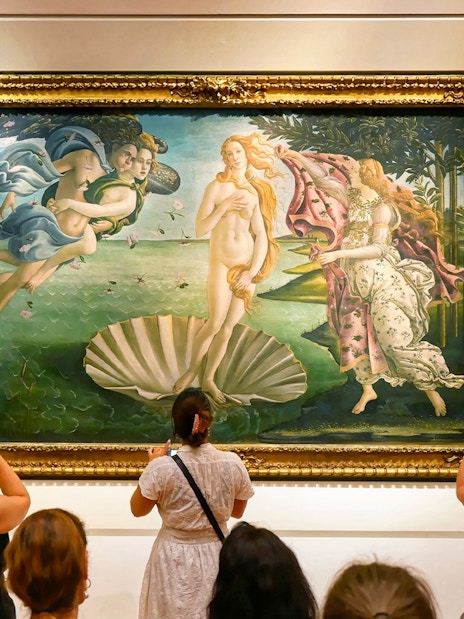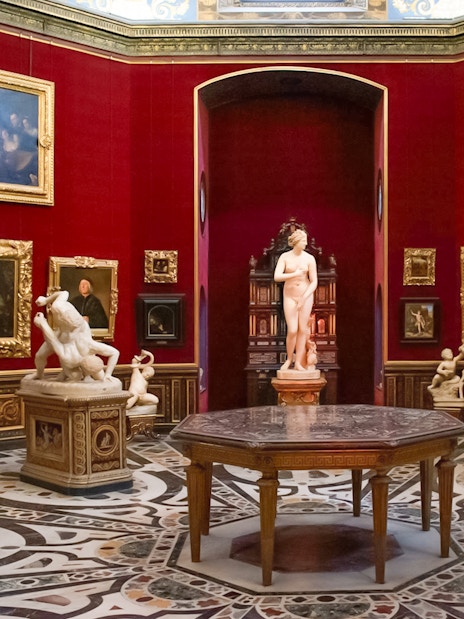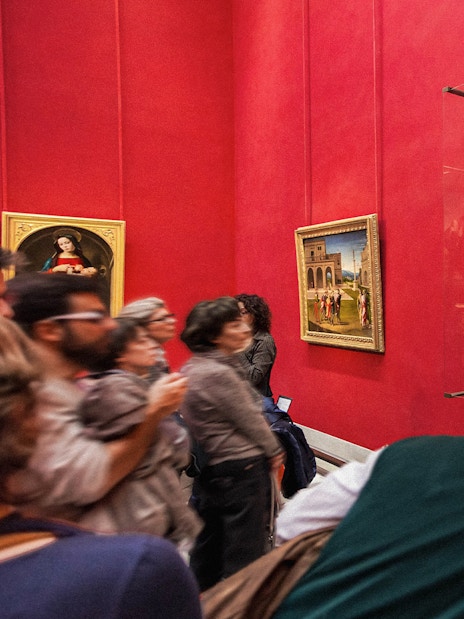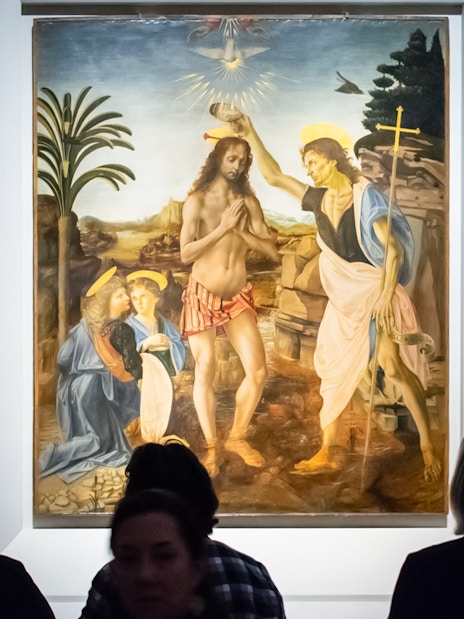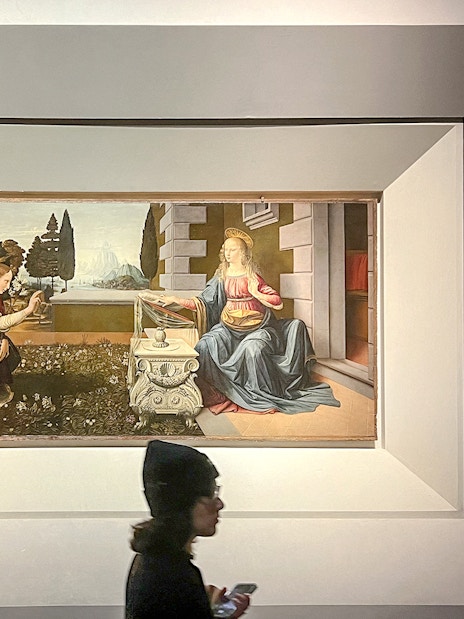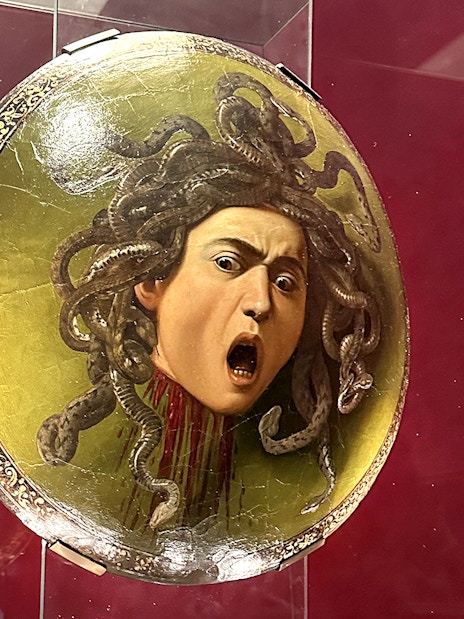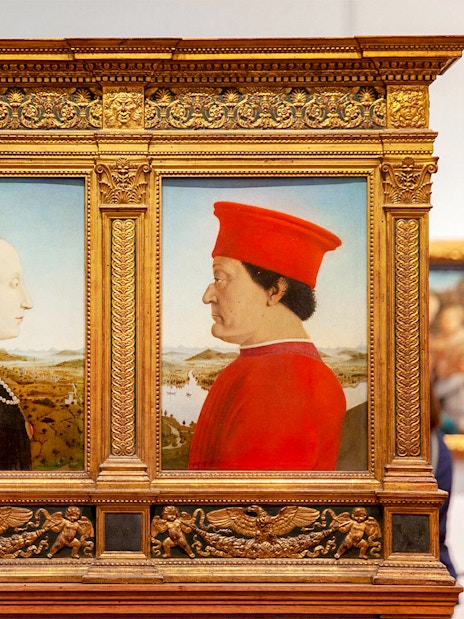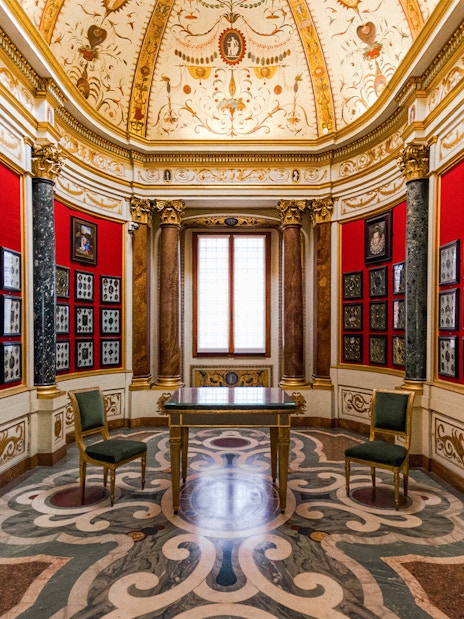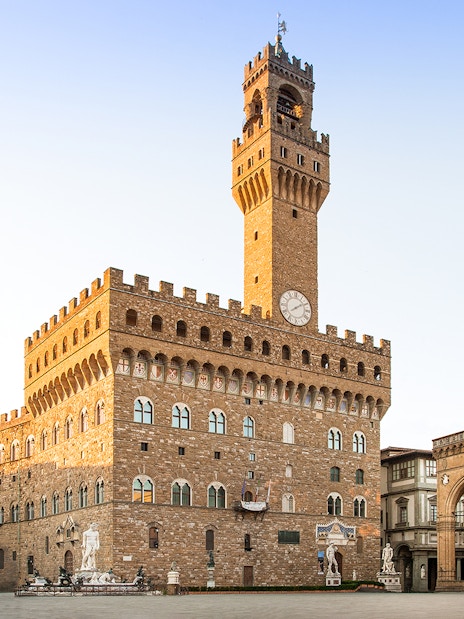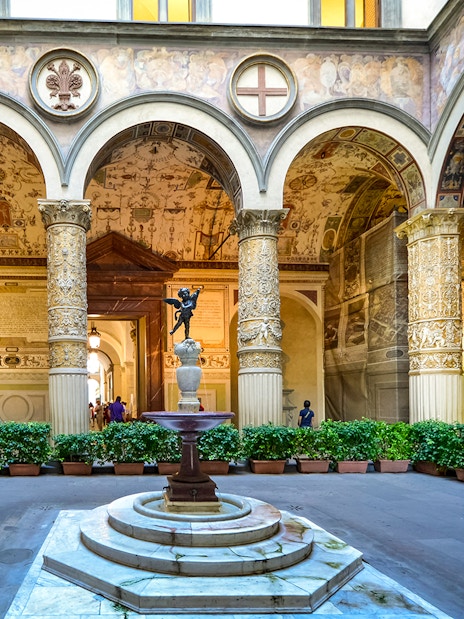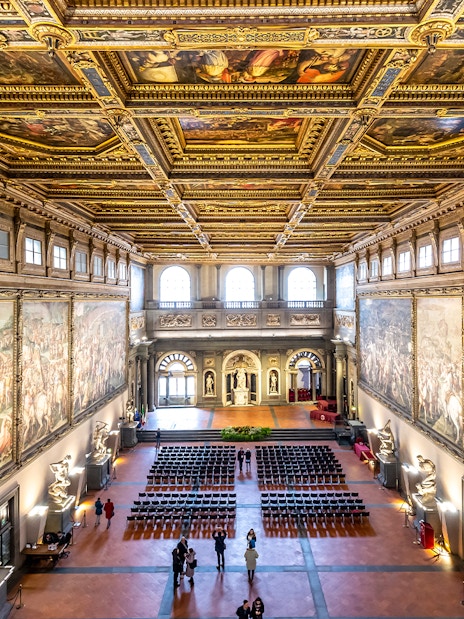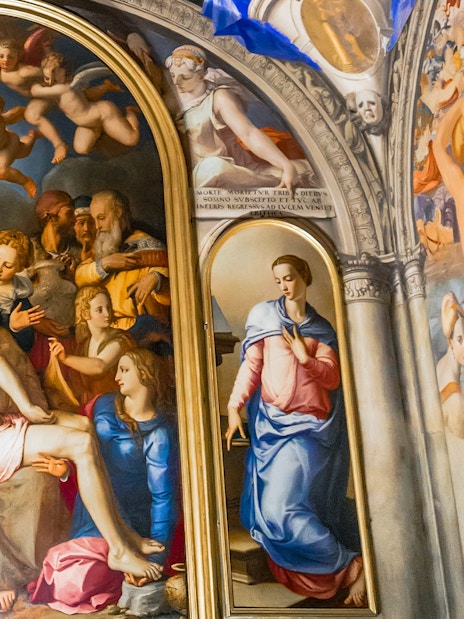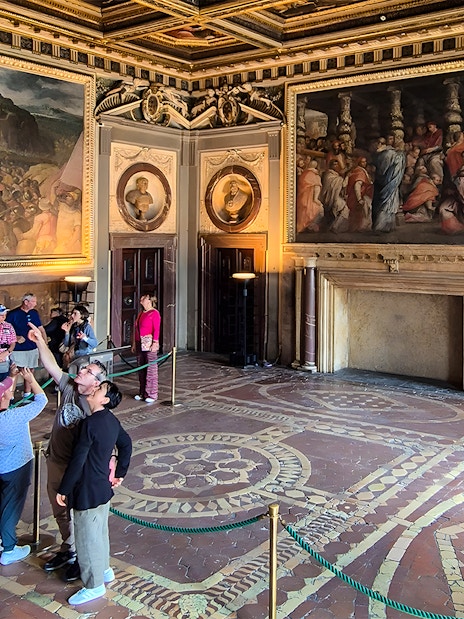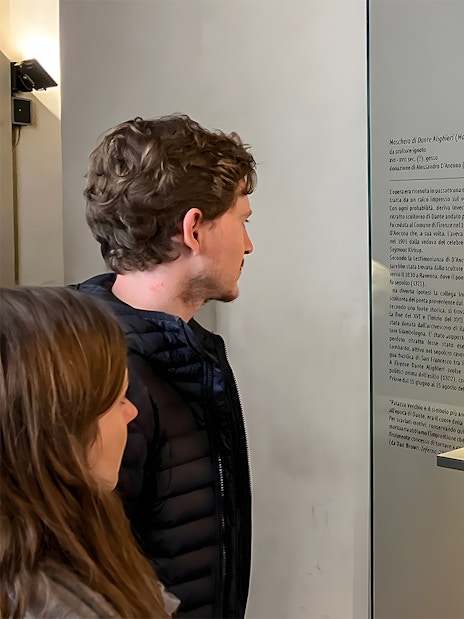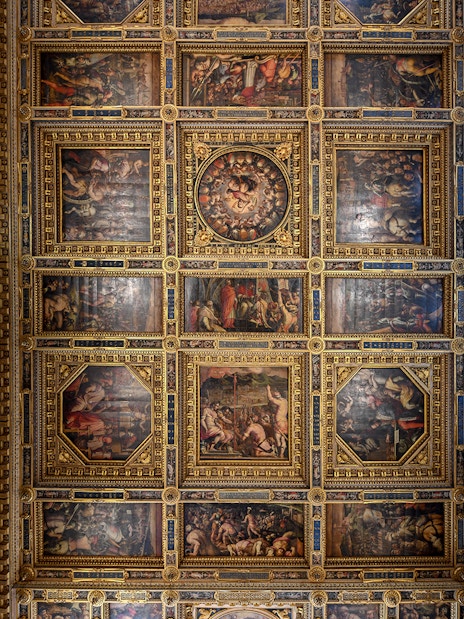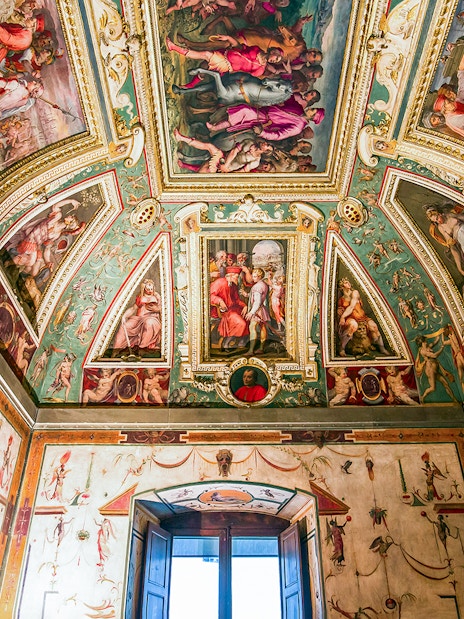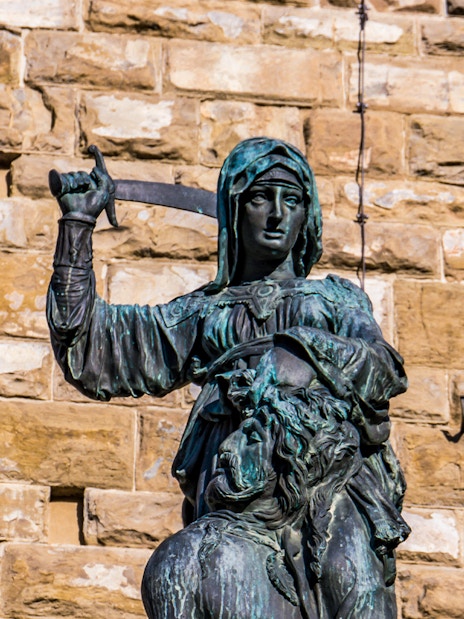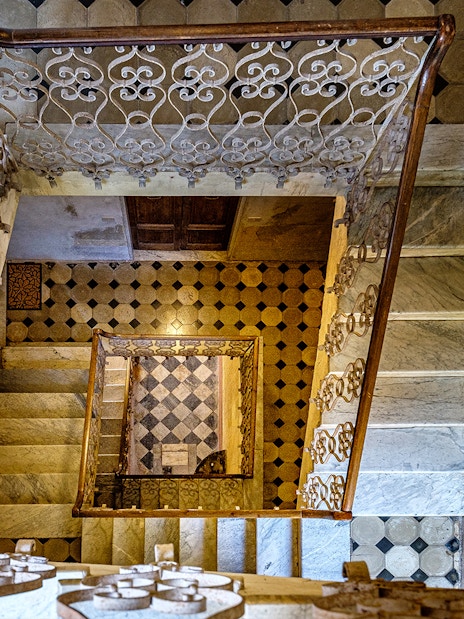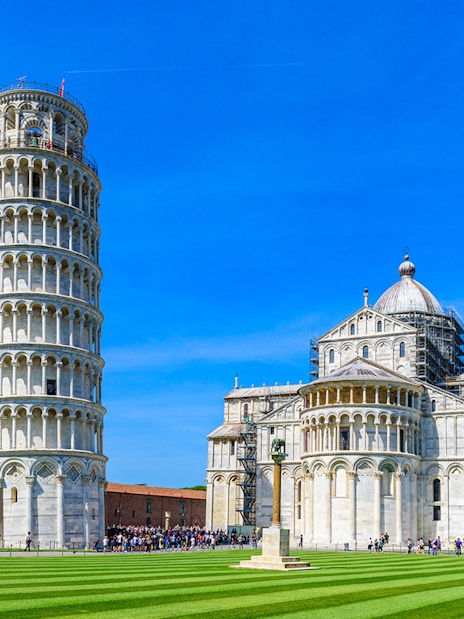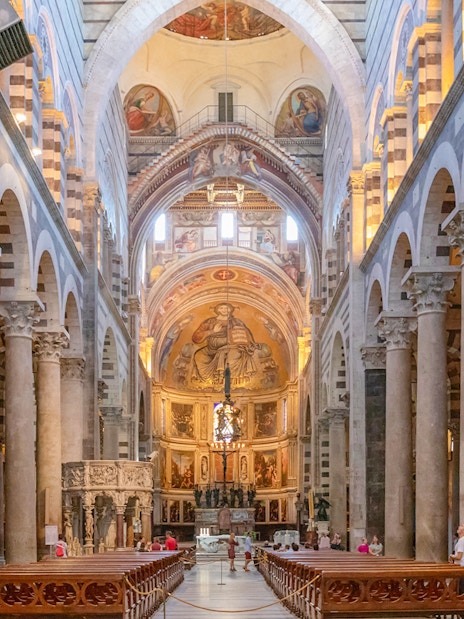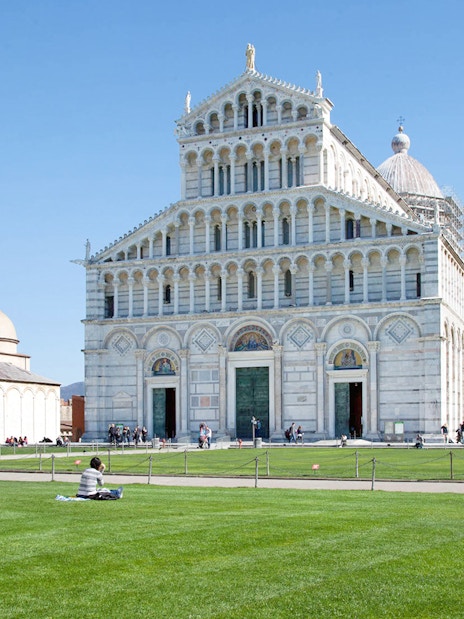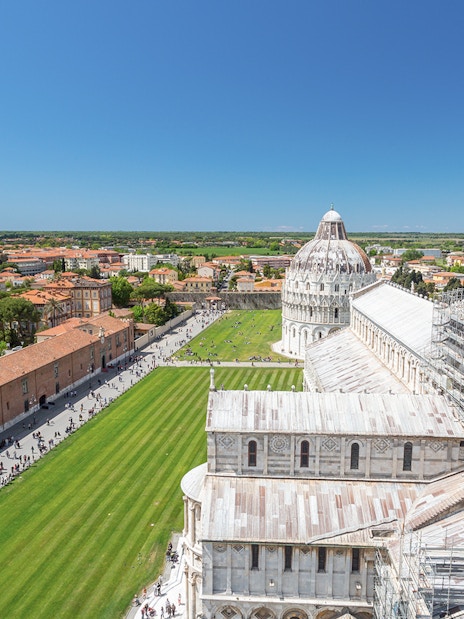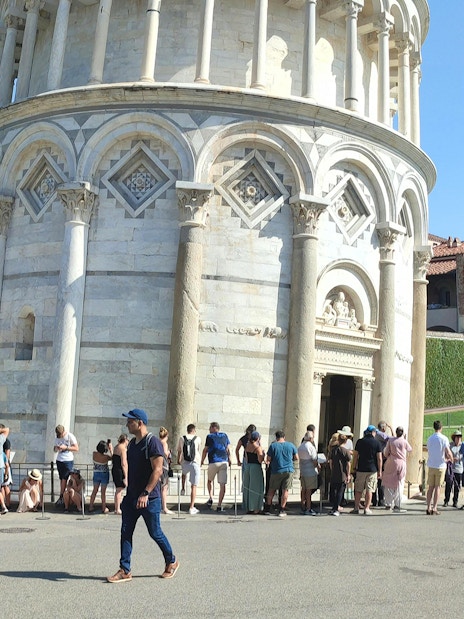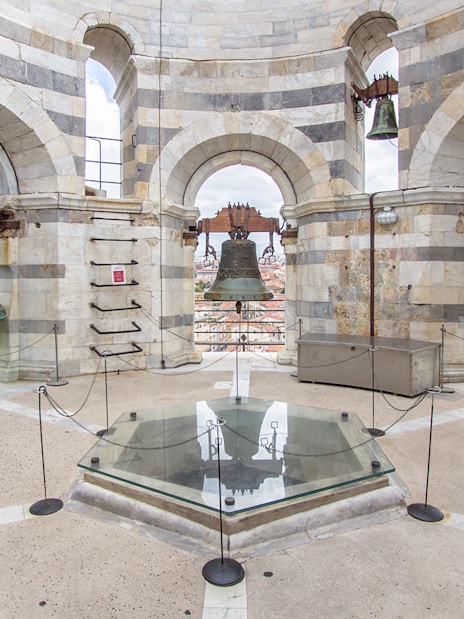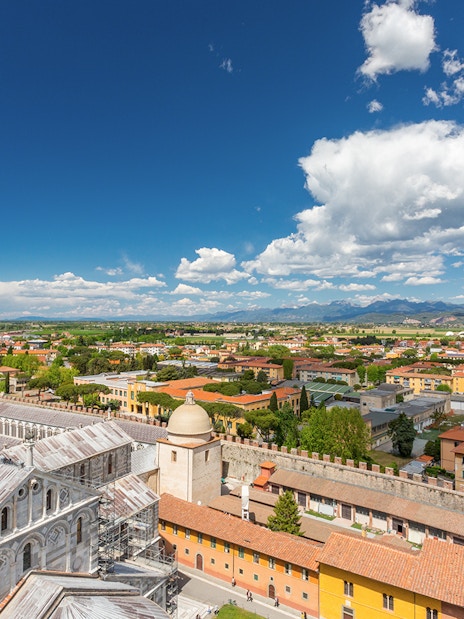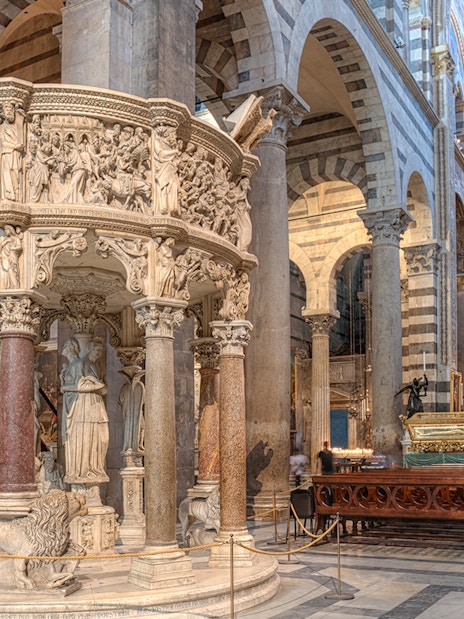- Uffizi Gallery
- Duomo Florence
- Accademia Gallery Tickets
- Palazzo Vecchio
- Florence To Chianti Tours
- Florence To Cinque Terre Tours
- Bargello National Museum
- Medici Chapel
- Florence To Pisa Tours
- Florence To Siena Tours
- Florence To Tuscany Tours
- Boboli Gardens
- Hzero - The Miniature Railway
- San Marco Museum
- Basilica of Santa Croce
- Brancacci Chapel
Reserve your slot and enjoy priority access with optional skip-the-line upgrades.
- Experience the iconic David by Michelangelo, standing over 17 feet high.
- Enjoy hassle-free exploration of Renaissance paintings, sculptures, and more with priority access.
- Stroll through the gallery's courtyard, its well-manicured gardens, and a massive stone well dating back to when the Accademia served as a monastery.
- Look out for famous sculptures such as Rape of the Sabines by Giambologna in Hall of The Colossus and Lorenzo Bartolini's works in Hall of Models.
- Upgrade your tickets to get a skip-the-line reserved entry led by a host or include multilingual audio guides to unravel the stories hidden behind masterpieces.
Reserve your slot and enjoy priority access with optional skip-the-line upgrades.
- Experience the iconic David by Michelangelo, standing over 17 feet high.
- Enjoy hassle-free exploration of Renaissance paintings, sculptures, and more with priority access.
- Stroll through the gallery's courtyard, its well-manicured gardens, and a massive stone well dating back to when the Accademia served as a monastery.
- Look out for famous sculptures such as Rape of the Sabines by Giambologna in Hall of The Colossus and Lorenzo Bartolini's works in Hall of Models.
- Upgrade your tickets to get a skip-the-line reserved entry led by a host or include multilingual audio guides to unravel the stories hidden behind masterpieces.
Inclusions
- Reserved entry to Accademia Gallery
- PDF guide in English, Italian, French, German, and Spanish
- Skip-the-line entry (as per option selected)
- Audio guide in English, French, Italian, Spanish, German & Chinese (as per option selected)
- Headsets (optional)
Exclusions
- Guided tour
- Hotel pickup and drop-off
- Note: The tickets offer reserved entry into the gallery. However, there may be a wait time when you're exchanging your voucher for the physical ticket.
- With the Reserved Entry with Host ticket, the host will assist in guiding you to the entrance and ensuring a smooth entry but will not serve as a tour guide.
- All guests are required to do the security check while entering.
- This experience is wheelchair and pram/stroller accessible.
- For security reasons, the gallery may adjust your time slot slightly based on availability.
- No animals are allowed, except guide dogs, service dogs, and certified therapy pets.
- Children under 12 must be with an adult.
- No food or drinks are allowed inside the museum.
- The Gallery has no cloakroom, so luggage, large backpacks, helmets, and items over 40x30x18 cm aren’t allowed.
- You are expected to turn off mobile phones or set them to silent.
- Flash photos, tripods and selfie sticks are not allowed.
- Re-entry is not allowed.
- Going for the audio guide? Simply ensure that the guides are downloaded on the Headout app before your visit. It’s super simple to use, and you get offline access with an easy language-switching feature.
- These tickets can't be cancelled or rescheduled.
Combo (Save 7%): Uffizi Gallery + Accademia Gallery Tickets
7% off
- Enjoy a combo ticket of two of Florence's most sought-after galleries, the Uffizi and the Accademia Gallery at a special price.
- At the Uffizi Gallery, you'll find yourself in the house of the world’s greatest collection of Italian Renaissance art.
- Enjoy the works of Giotto, Michelangelo, Da Vinci, Raphael, Caravaggio, and many more as you wander the halls of this gallery at your own pace.
- Delve into the works of art ranging from the 12th century to the 17th century, including Botticelli's famed Birth of Venus.
- At the Accademia Gallery, peruse the gallery's stunning collection, including priceless masterpieces. A must-see piece of art on display is, of course, Michelangelo’s David.
- Be greeted by glittering mosaics and vibrant colors at the Florentine Gothic Rooms, see the Hall of Colossus, the Hall of Prisoners, and much more.
- Enjoy a combo ticket of two of Florence's most sought-after galleries, the Uffizi and the Accademia Gallery at a special price.
- At the Uffizi Gallery, you'll find yourself in the house of the world’s greatest collection of Italian Renaissance art.
- Enjoy the works of Giotto, Michelangelo, Da Vinci, Raphael, Caravaggio, and many more as you wander the halls of this gallery at your own pace.
- Delve into the works of art ranging from the 12th century to the 17th century, including Botticelli's famed Birth of Venus.
- At the Accademia Gallery, peruse the gallery's stunning collection, including priceless masterpieces. A must-see piece of art on display is, of course, Michelangelo’s David.
- Be greeted by glittering mosaics and vibrant colors at the Florentine Gothic Rooms, see the Hall of Colossus, the Hall of Prisoners, and much more.
Inclusions
- Admission ticket to the Uffizi Gallery
- Admission ticket to the Accademia Gallery
- Due to security reasons, the gallery can only accommodate a certain number of people at any given time so, if space allows, you may be moved to a slightly earlier or later time slot upon arrival.
- Kindly note that your tickets allow skipping the entry line into the gallery. However, there may be a wait at the ticket office across from the museum when you're exchanging your voucher for the physical ticket.
- Note: The booking fee is included in the ticket price.
- These tickets can't be cancelled or rescheduled.
- Say goodbye to ticketing queues and dive right into the artistic wonders of Uffizi Gallery. Skip-the-line access helps you make the most of your visit!
- Enjoy assistance from the host and be personally escorted into the gallery.
- Iconic masterpieces like Filippo Lippi’s Madonna and Child and Sandro Boticelli's Primavera await your discovery.
- Watch fantastical Biblical and mythical imagery come to life in the works of maestros like Michelangelo and Raphael!
- Audio guides will enhance your experience with special tidbits and insights into the craftsmanship of Raphael and da Vinci.
- Say goodbye to ticketing queues and dive right into the artistic wonders of Uffizi Gallery. Skip-the-line access helps you make the most of your visit!
- Enjoy assistance from the host and be personally escorted into the gallery.
- Iconic masterpieces like Filippo Lippi’s Madonna and Child and Sandro Boticelli's Primavera await your discovery.
- Watch fantastical Biblical and mythical imagery come to life in the works of maestros like Michelangelo and Raphael!
- Audio guides will enhance your experience with special tidbits and insights into the craftsmanship of Raphael and da Vinci.
Inclusions
- Skip-the-line access to Uffizi Gallery
- Hosted entry (as per option selected)
- Audio guide (as per option selected)
- Access to Vasari Corridor (as per option selected)
- Tip: Numerous artists including Raphael, Dolci, and Boticelli have created their own rendition of Madonna and Child, with over 21 canvases on the subject displayed at Uffizi. Try to spot them all!
- Every first Sunday of the month, the museum follows normal opening hours and entry is free for everyone.
- While this ticket lets you bypass the ticketing queue, security checks still apply.
- Re-entry is not allowed once you leave the gallery.
- Children aged 18 years and under can enter the gallery for free. You can issue these tickets on the day of your visit, at the same desk where adults exchange their mobile vouchers.
- Going for the audio guide? Simply ensure that the guides are downloaded on the Headout app before your visit. It’s super simple to use, and you get offline access with an easy language-switching feature.
- These tickets can't be cancelled or rescheduled.
Jump past ticket queues to Florence's grand townhall, and upgrade for an audio guide.
- Gain direct entry to elaborately furnished courtyards, halls filled with Renaissance masterpieces, and lavish apartments once occupied by the Medici family.
- With an optional audio guide, get a complete understanding as you explore all three floors of this legendary museum and seat of the Florence city council.
- See Donatello’s famed bronze sculpture of Judith assassinating the Assyrian general Holofernes, and Michelangelo’s Genius of Victory statue.
- Add on a tour of Palazzo Vecchio's mysterious secret passages and enter a door hidden behind a painting!
Jump past ticket queues to Florence's grand townhall, and upgrade for an audio guide.
- Gain direct entry to elaborately furnished courtyards, halls filled with Renaissance masterpieces, and lavish apartments once occupied by the Medici family.
- With an optional audio guide, get a complete understanding as you explore all three floors of this legendary museum and seat of the Florence city council.
- See Donatello’s famed bronze sculpture of Judith assassinating the Assyrian general Holofernes, and Michelangelo’s Genius of Victory statue.
- Add on a tour of Palazzo Vecchio's mysterious secret passages and enter a door hidden behind a painting!
Inclusions
- Skip-the-line entry to Palazzo Vecchio
- Audio guide in English, Italian, Spanish, French, German, Dutch & Portuguese (as per option selected)
- Multimedia tablet (as per option selected)
- English guided tour of the secret passages (as per option selected)
Exclusions
- Headsets & mobile device
- Tip: Until March 6, 2025, your Palazzo Vecchio tickets include entry to the "La sala grande. Giorgio Vasari per Cosimo I de’ Medici exhibition"—don’t miss it!
- The two main floors of the museum are wheelchair accessible, but architectural barriers prevent access to the mezzanine floor and the Secret Passages.
- Guests with disabilities can enter the museum for free. Visitors with mobility issues can access the building via the side entrance in Via dei Gondi.
- The lift, situated on the ground floor in the Cortile della Dogana, is for visitors with reduced mobility only.
- Visitors must leave umbrellas, backpacks, and large bags in the cloakroom. Wheelchairs and strollers may be borrowed here free of charge.
- Please present a valid photo ID along with your ticket at the info point of Palazzo Vecchio.
- These tickets can't be cancelled or rescheduled.
Enjoy reserved access to Pisa’s Leaning Tower. Upgrade for a multilingual audio guide.
- Bypass the ticket office and head directly to the top of the Leaning Tower with timed entry access.
- Gaze at unparalleled panoramas of the city from 185 ft up, peering out amidst the tower’s unique bells.
- Discover the gorgeous Romanesque Pisa Cathedral, a white and black striped marble masterpiece adorned with intricate sculptures and mosaics.
- Add an audio guide in your preferred language to uncover a fascinating history of plundered loot, treacherous subsoil, engineering missteps, and more!
Enjoy reserved access to Pisa’s Leaning Tower. Upgrade for a multilingual audio guide.
- Bypass the ticket office and head directly to the top of the Leaning Tower with timed entry access.
- Gaze at unparalleled panoramas of the city from 185 ft up, peering out amidst the tower’s unique bells.
- Discover the gorgeous Romanesque Pisa Cathedral, a white and black striped marble masterpiece adorned with intricate sculptures and mosaics.
- Add an audio guide in your preferred language to uncover a fascinating history of plundered loot, treacherous subsoil, engineering missteps, and more!
Inclusions
- Timed entry to the Leaning Tower of Pisa
- Access to Pisa Cathedral
- Audio guide in English, French, Spanish & Italian (as per option selected)
Exclusions
- Access to the Baptistery of St. John
- Access to Camposanto
- Access to Opera del Duomo Museum
- Access to Sinopie Museum
- Tickets are timed. Please check the time of your visit. If you are late you will not be allowed in.
- Due to high demand, your chosen time slot may not be available: if this happens you will be allocated a new slot an hour before or after your original choice. Please note that you will only be allowed at the top of the tower for 30 minutes.
- The climb involves 294 steep steps with no elevators, so it is not accessible for wheelchair users and guests with cardiovascular issues.
- For safety reasons, children under 8 are not allowed to climb, and those aged 8-18 must be accompanied by an adult.
- Strict dress code: Since the Cathedral is a place of worship, all guests must wear clothing that covers their shoulders and knees.
- Free lockers are available for personal belongings at 21 Piazza del Duomo – metal objects, bags, or containers are not allowed in.
- Going for the audio guide? Simply ensure that the guides are downloaded on the Headout app before your visit. It’s super simple to use, and you get offline access with an easy language-switching feature.
- These tickets can't be cancelled or rescheduled.
30 Best Places to Visit in Florence

1. Uffizi Gallery
Gallery | Must See
Florence's prestigious gallery, the vast U-shaped Palazzo Degli Uffizi, was built as a government building and houses the world's greatest catalog of Italian Renaissance art. The Medici family bestowed the collection to the city in 1743 on the condition that it never leave Florence
Why Visit: The Birth of Venus by Renaissance painter Sandro Botticelli is arguably his best work. This work, which is around 10 feet long, is on display at the Uffizi Gallery.
Tip: Keep your ticket with you the entire time you are there because you could need to show it at any point.
Location: Piazzale degli Uffizi, 6, 50122 Firenze FI, Italy Find on map
from €29
2. Boboli Gardens
Leisure | City Landmark
The fountain- and sculpture-adorned Boboli Gardens were arranged in the mid-16th century to a layout by architect Niccol Pericoli and are slowly but steadily being repaired to their former immaculate splendor thanks to a €2 million financing by Florence's domestic fashion house Gucci.
Why Visit: The Boboli Gardens, which feature numerous sculptures, grottoes, and fountains, is Florence's largest outdoor museum.
Tip: Spend some time exploring the sculpture and buildings in the Renaissance style. Enjoy viewing the magnificent sculptures and pieces of art, such as the imposing Fountain of Neptune or the 6-meter-tall obelisk.
Location: Piazza de' Pitti, 1, 50125 Firenze FI, Italy Find on map
from €16
3. Accademia Gallery
Museum | Must See
A line forms outside the door to this gallery, which was built to house Michelangelo's David, one of the Renaissance's most recognizable masterpieces. However, the world's most renowned statue is well worth the wait. Michelangelo was also the mastermind behind the gallery's incomplete San Matteo and four Prigioni.
Why Visit: Of course, Michelangelo's David in The Tribune Hall is a must-see work of art that is on display at the Accademia Gallery.
Tip: As a result of the Accademia Gallery's fame, expect lengthy lineups at the door. Choosing skip-the-line tickets is the greatest method to save time.
Location: Via Ricasoli, 58/60, 50129 Firenze FI, Italy Find on map
from €20
4. Duomo Florence
City Landmark | Must See
The Duomo di Florence is the city's most recognizable landmark. It's a massive structure topped by Filippo Brunelleschi's red-tiled cupola, with stunning pink, white, and green marble facade and elegant campanile dominating the Renaissance cityscape. Arnolfo di Cambio, a Sienese architect, began work on it in 1296.
Why Visit: To get a panoramic perspective of Florence, climb to the summit of the Cupola, which is the highest point in the city.
Tip: To avoid heavier crowds and drawn-out wait times, early mornings on weekdays are the best time to visit the Florence Duomo.
Location: Piazza del Duomo, 50122 Firenze FI, Italy Find on map
from €15
5. Palzzo Pitti
Historical Landmark
This Renaissance palace was authorized by banker Luca Pitti in 1458 and later purchased by the Medici family. It was a domicile of the city's rulers for centuries. It now houses a remarkable selection of silver and jewelry, two art museums, and a series of rooms that recreate life in the palace during the House of Savoy's reign.
Why Visit: Over 500 works of art, mostly from the Renaissance era, that were once part of the Medici family's private collections are now shown in the main Gallery.
Tip: Avoid bringing camera equipment because you'll have to leave it in the cloakroom and won't be able to use it.
Location: Piazza de' Pitti, 1, 50125 Firenze FI, Italy Find on map
from €24
6. Palazzo Vecchio
Historical Landmark
Arnolfo di Cambio designed this palace for the city government between 1298 and 1314, complete with crenellations and a 94m-high tower. It now houses the mayor's headquarters and the municipal council. You can enjoy breathtaking views from the top of the Torre di Arnolfo.
Why Visit: Discover the ornately decorated ceilings and statues that may be seen in the courtyards, halls, and opulent apartments. You may get an idea of the riches of Florence during the height of the Renaissance by looking at these.
Tip: Accessible entry is available at Via Dei Gondi through a side door. Wheelchair users can access the Palazzo Vecchio's two main floors.
Location: P.za della Signoria, 50122 Firenze FI, Italy Find on map
from €17
7. Basilica of Santa Maria Novella
Religious Landmark | Must See
The striking green-and-white marble facade of the 13th to 15th-century Basilica di Santa Maria Novella flaunts a monastic complex that includes romantic church cloisters and a frescoed chapel. The basilica itself is a treasure trove of artistic masterpieces, culminating in Domenico Ghirlandaio's frescoes.
Why Visit: One of the first works of art to employ the then-recently discovered techniques of perspective and proportion is Masaccio's magnificent fresco Trinità, which you can see straight ahead as you enter.
Tip: Backtrack through the museum to the brilliantly frescoed Great Cloister (Chiostro Grande; 1340–60), so named for its imposing grandeur.
Location: P.za di Santa Maria Novella, 18, 50123 Firenze FI, Italy Find on map

8. Museo del Bargello
Museum
From the 13th century until 1502 the podestà (governing magistrate) delivered justice behind the stark walls of Palazzo del Bargello, Florence's first public building. Today, the structure houses Italy's most complete selection of Tuscan Renaissance statues, including some of Michelangelo's earliest works and several by Donatello.
Why Visit: The Tondo Pitti by Michelangelo, the David by Donatello, the bust of Cosimo I by Cellini, and the Mercury by Giambologna are some of the important works to see.
Tip: Discover what life was like in 15th-century Florence by visiting the coin, garment, and armor exhibits. Reduced ticket prices are available for children ages 0 to 17 and young people ages 18 to 25.
Location: Via del Proconsolo, 4, 50122 Firenze FI, Italy Find on map
from €18.50
9. Medici Chapels
City Landmark | Historical Landmark
Nowhere is the Medici premise more explicit than in the Medici Chapels. It is the burial site of 49 dynasty members and is decorated with granite, marble, semiprecious stones, and some of Michelangelo's most gorgeous sculptures. Francesco I is buried alongside Ferdinando I and II, as well as Cosimo I, II, and III, in the dark, enforcing Cappella Dei Principi (Chapel of Princes).
Why Visit: It is regarded as one of the finest examples of Italian Renaissance architecture. The Chapel of the Princes, the Medici family's most opulent chapel, is a majestic octagonal structure topped by a huge dome.
Tip: With your priority access ticket, you can enter without waiting in the lengthy lineups outside.
Location: Piazza di Madonna degli Aldobrandini, 6, 50123 Firenze FI, Italy Find on map
from €15
10. Siena Cathedral
Religious
Built in 1255 AD in honor of the Virgin Mary by Pope Alexander IV, Siena Cathedral is the most significant church in the city. A little chapel, known as the "Old Cathedral of Siena" previously stood where the cathedral now stands. Up until 1549, the Bishop of Siena had his office at the Old Cathedral of Siena.
Why Visit: Seven pairs of double doors of the Siena Cathedral feature bronze panels that tell New Testament tales. Visitors are drawn to the cathedral's 77 enormous stained glass windows, which were made by a variety of different artisans.
Tip: Since Siena Cathedral is home to a sizable collection of historical items, it is best to refrain from touching or otherwise disturbing any of the museum's displays in order to preserve them.
Location: Piazza del Duomo, 8, 53100 Siena SI, Italy Find on map
from €9
11. Museo di San Marco
Religious Monument
The Chiesa di San Marco and an adjoining 15th-century Dominican monastery, where both the talented painter Fra' Angelico and the sharp-tongued Savonarola righteously served God, are located in the heart of Florence's university area. Today, the monastery also exhibits Fra' Angelico's work.
Why Visit: The mural by Giovanni Antonio Sogliani Within the cloister, the ancient monks' Refettorio (Refectory) is dominated by St. Dominic's Miraculous Supper (1536).
Tip: The three little chambers, kept as a sort of shrine to the troubled priest, contain a portrait, a few belongings, and pieces of the black cape and white tunic Savonarola wore.
Location: Piazza San Marco, 3, 50121 Firenze FI, Italy Find on map
Know more
12. Piazzale Michelangelo
City Landmark
Turn your back on the horde of tacky souvenir shops peddling David sculptures and boxer shorts and gaze out across the magnificent cityscape from this enormous square, which is punctured by one of Florence's two David replicas. From the Arno, it's a 10-minute climb up the hillside on a serpentine road, pathways, and steps.
Why Visit: The sunset from this is spectacular and one of the sights that you must catch when you are in Florence.
Tip: You can take bus 13 from Stazione di Santa Maria Novella and reach this beautiful spot if you don't want to go through with the climb.
Location: Piazzale Michelangelo, 50125 Firenze FI, Italy Find on map

13. Giardino Torrigiani
Leisure | Family Friendly
The Torrigiani Malaspina and Torrigiani di Santa Cristina families possess Europe's largest privately held open park within a historic center, which is hidden behind the plain facades of Via de' Serragli. Visit this well-kept and adored wooded retreat while engrossed in the captivating company of the affable Marquis Vanni Torrigiani Malaspina.
Why Visit: The three floors of the tower, which spiral from the garden to the heavens, represent the three steps of the initiation process. The garden design is rich with intricate Masonic symbolism.
Tip: If you are looking for a quiet place to spend some time during the torrid bout of sightseeing in Florence, this garden will be a great place to return to.
Location: Via Dei Serragli, 144, 50124 Firenze FI, Italy Find on map
Know more
14. Ponte Vecchio
City Landmark
The famous Ponte Vecchio, built in 1345, was the only bridge in Florence to escape being destroyed by German forces in 1944. The Corridoio Vasariano, a 16th-century corridor between the Uffizi and Palazzo Pitti, circles the historic Torre Dei Mannelli at the bridge's southern end and is located above jewelry stores on the eastern side.
Why Visit: The bridge is one of the liveliest places to visit in Florence. If you are planning to go budget shopping, this is the place to be.
Tip: Keep your eyes on your belongings when you are visiting the bridge as the place is a popular hunting ground for pickpockets and miscreants.
Location: Ponte Vecchio, 50125 Firenze FI, Italy Find on map

15. Basilica di Santa Croce
Religious | Architecture
The majestic neo-Gothic front of this Franciscan cathedral is enlivened by many tones of colored marble, so the austere interior comes as a shock. Between 1294 and 1385, Arnolfo di Cambio created the basilica, which takes its name from a shard of the Holy Cross that King Louis IX of France contributed in 1258.
Why Visit: The tombs of Michelangelo, Galileo, and Ghiberti are the main attractions for visitors, but the actual highlights are the frescoes by Giotto in the chapels to the right of the altar.
Tip: Look for the numerous frescoed chapels inside the basilica to discover the sheer architectural wealth of this place.
Location: Piazza di Santa Croce, 16, 50122 Firenze FI, Italy Find on map
Know more
16. Villa e Giardino Bardini
City Landmark | Leisure
The 17th-century villa and garden bear the name of Stefano Bardini (1836–1922), a 19th-century antiquarian art collector who acquired it in 1913 and restored its attractive medieval garden. It has artificial grottoes, an orangery, marble statues, fountains, and other characteristics of a classic Tuscan garden.
Why Visit: Italian painter Pietro Annigoni's works are on exhibit in the villa's tiny Museo Pietro Annigoni (1910–88). Finish with a lovely roof terrace view of the city.
Tip: Visit the garden during the delightful months of April and May when the azaleas, peonies, and wisteria are in bloom.
Location: Via de' Bardi, 1, 50125 Firenze FI, Italy Find on map
Know more
17. Museo di Palazzo Davanzati
Historic | Architecture
This 14th-century palace with a beautiful central loggia provides you a peek into exactly how Florentine nobles lived in the 16th century and was the residence of the affluent Davanzati merchant family from 1578. This is a great offbeat site to visit when in Florence.
Why Visit: Visit the fascinating Sala dei Pappagalli, Camera dei Pavoni, the first-floor Sala Madornale with its painted wooden ceiling, and the carved faces of the ancient owners on the pillars in the inner courtyard.
Tip: Only guided tours that depart at 10 a.m., 11 a.m., and noon on weekdays and at 3 p.m., 4 p.m., and 5 p.m. on weekends are allowed to access the palace's second and third floors.
Location: Via Porta Rossa, 13, 50123 Firenze FI, Italy Find on map
Know more
18. Chiesa e Museo di Orsanmichele
Religious | Architecture
The arches of an old grain market (1290) were walled in and two stories were built throughout the 14th century, creating this remarkable and inspired church with a Gothic tabernacle by Andrea Orcagna. The exterior of it is embellished with niches and tabernacles holding statues of the different guilds of Florence's patron saints.
Why Visit: The statues present in the structure today represent the work of some of the greatest Renaissance artists and are worth the visit.
Tip: If you are visiting Piazza Della Signoria, you can take a short stroll to Chiesa e Museo di Orsanmichele.
Location: Via dell'Arte Della Lana, 50123 Firenze FI, Italy Find on map
Know more
19. Museo degli Innocenti
Architecture | Museum
The loggia for Florence's Ospedale Degli Innocenti, Europe's first orphanage established by the affluent silk-weavers guild to care for unwanted infants, was planned by Brunelleschi not long after it was founded in 1421. Inside, a cutting-edge museum that analyzes its past is really moving.
Why Visit: The incorporation of Roman capitals and rounded arches by Brunelleschi makes it possibly the first Renaissance structure. It is worth visiting this place just to spot these details.
Tip: The museum features a breathtaking collection of frescoes and artwork that used to decorate the hospital as well as a lovely rooftop café patio with stunning city views.
Location: Piazza Della Santissima Annunziata, 13, 50122 Firenze FI, Italy Find on map
Know more
20. Basilica di Santa Trinità
Religious
This 14th-century church contains some of the best frescoes in the city. It was originally built in the Gothic style and later given a mannerist facade. Ghirlandaio's paintings (1483–1485) in Cappella Sassetti, located to the right of the main altar, reflect St. Francis of Assisi's life via portraits of prominent Florentines of the time.
Why Visit: The Annunciation (1422) by Lorenzo Monaco is shown above the altar in Cappella Bartolini Salimbeni, the walled side chapel. Wall frescoes depict the life of the Virgin Mary.
Tip: On the chapel floor, keep an eye out for the Bartolini Salimbeni family crest, which has the motto "Per Non-Dormire" and poppies.
Location: Piazza di Santa Trinita, 50123 Firenze FI, Italy Find on map
Know more
21. Palazzo Strozzi
City Landmark
One of the Medici family's main political and financial enemies, wealthy trader Filippo Strozzi, had this Renaissance home constructed for him in the 15th century. Today, it presents fascinating exhibitions of art from many eras and genres; its contemporary art events are especially noteworthy.
Why Visit: Fashionable Florentines congregate in the exquisite interior courtyard of the palace and linger over beverages at Strozzi Caffè during important exhibitions, adding to the lively atmosphere of the location.
Tip: The gallery is a crowd favorite thanks to its family-friendly art workshops, tours, and other events.
Location: Piazza Degli Strozzi, 50123 Firenze FI, Italy Find on map
Know more
22. Via de’ Tornabuoni
City Street
The most luxurious shopping street in the city, Via de Tornabuoni, is surrounded by Renaissance palaces and Italian fashion businesses. It is known as the "Salotto di Firenze," or "Florence's Drawing Room," after a prominent Florentine family. The aristocratic Antinori family has owned Palazzo Antinori (1461-69) at its northernmost point since 1506.
Why Visit: If you are visiting Florence, coming to this street is the first thing you should do as it is the liveliest part of the city.
Tip: Visit Via de’ Tornabuoni after sunset to see the place in all its twinkling glory.
Location: 50123 Florence, Metropolitan City of Florence, Italy Find on map

23. The Mall Firenze
Shopping mall
Florence is a great place to shop because of outlet malls like this one. There are several outlets at The Mall Firenze, including Gucci, Prada, Tom Ford, and a rooftop cafe that serves great coffee. The outlets at this mall often offer discounts on all products.
Why Visit: The Mall Firenze is one of the best shopping malls to head to in Florence because of the wide variety of products available and the location.
Tip: Located a bit outside the city limits, this mall offers you a great opportunity to explore the surroundings of Florence and have a quiet day out.
Location: Via Europa, 8, 50066 Leccio FI, Italy Find on map
Know more
24. Palazzo Medici Riccardi
Sightseeing
In 1444, Cosimo the Elder commissioned Michelozzo to create the family's townhouse. This palace was the end outcome, and it served as a model for other Florentine family homes, including Palazzo Pitti and Palazzo Strozzi. The Medici family as well as the Riccardi family inhabited this palace at one point.
Why Visit: One of the pinnacles of Renaissance art is the upper chapel, Cappella dei Magi, which is filled in exquisitely detailed murals by Benozzo Gozzoli, a student of Fra' Angelico (c. 1459–1433).
Tip: If you are looking for a laidback tour of historical Florence, this is the ideal place to visit as it is usually not swarmed by tourists even in high season.
Location: Via Camillo Cavour, 3, 50129 Firenze FI, Italy Find on map

25. Piazza della Signoria
Sightseeing | Leisure
Since the 13th century, Florentines have flocked to this area to socialize with friends and have pre-dinner beverages at storied cafes. Whenever the city experienced one of its countless political crises in earlier centuries, the town's residents would gather on the piazza.
Why Visit: Agnolo Gaddi's Seven Virtues and Giambologna's Rape of the Sabine Women are among the Renaissance sculptures on display in Loggia dei Lanzi, an outdoor gallery (1384–89).
Tip: Don't overlook the much-photographed replica of Michelangelo's David or the equally stunning equestrian monument of Cosimo I by Giambologna in the center of the square.
Location: P.za della Signoria, 50122 Firenze FI, Italy Find on map
26. Museo Galileo
Sightseeing | Museum
This cutting-edge science museum is named after the famous scientist Galileo Galilei, who was born in Pisa and was invited by the Medici court to Florence in 1610. It is located on the Arno river next to the Uffizi in the 12th-century Palazzo Castellani - look for the sundial telling the time on the pavement outside.
Why Visit: A trip to the museum reveals a fascinating collection of astronomical and mathematical artifacts that Cosimo I and other Medicis amassed over the years, including telescopes, gorgeously painted globes, barometers, watches, clocks, and more
Tip: Don't overlook the showing of two of his fingers and a tooth.
Location: Piazza dei Giudici, 1, 50122 Firenze FI, Italy Find on map
Know more
27. Parco Delle Cascine
Sightseeing | Leisure
The largest park in Florence has many playgrounds and is a nice location for kids to run around. On weekends, families take over, and the park comes alive. The Medici dukes established this as an exclusive hunting preserve, but Peter Leopold made it accessible to the general public in 1776.
Why Visit: Rajaram Cuttiputti, an Indian maharajah who passed away from gastroenteritis while on vacation in Florence in 1870, is memorialized at the park's furthest westernmost point.
Tip: Le Pavoniere swimming pool is also available during the summer. You can also bike, rollerblade, and fly kites in the park.
Location: Piazzale Delle Cascine, 50144 Firenze FI, Italy Find on map
Know more
28. Gucci Garden
Leisure
Gucci Garden is an extravagantly whimsical monument to the Florentine fashion tycoon, and it is tastefully housed in the 14th-century Palazzo Della Mercanzia. The history of the 1921-founded company is displayed through apparel, accessories, multimedia projects, and a hugely popular "selfie" wall bearing the recognizable double-G monogram.
Why Visit: The bottom floor's almost psychedelic, the boudoir-styled boutique is intended more for immersive browsing than for high-end shopping, while the first and second floors' gallery rooms tell the Gucci narrative.
Tip: The modest ground-floor restaurant marked by Gucci, Osteria da Massimo Bottura, is open to the public for no charge.
Location: P.za della Signoria, 10, 50122 Firenze FI, Italy Find on map
Know more
29. Basilica di San Lorenzo
Religious
This incomplete basilica served as both the Medici family mausoleum and the parish church and is regarded as one of Florence's most harmonious examples of Renaissance architecture. It was constructed over a church from the fourth century and was planned by Brunelleschi in 1425 for Cosimo the Elder.
Why Visit: Look for Brunelleschi's incredibly exquisite Sagrestia Vecchia (Old Sacristy), which features sculptural embellishments by Donatello, in the somber interior.
Tip: The actual burial site of Donatello is located in the basilica crypt, which is now a part of the San Lorenzo Museum of Treasures.
Location: Piazza di San Lorenzo, 9, 50123 Firenze FI, Italy Find on map
Know more
30. Galleria Palatina
Architecture | Gallery
In the remarkable collection of 16th to 18th-century artwork accumulated by the Medici and Lorraine dukes, Raphaels and Rubens compete for center stage in the Galleria Palatina of the Palazzo Pitti. The gallery is loaded with several known works of art and is a must-visit.
Why Visit: Highlights include Botticelli's Portrait of a Woman in the Sala di Prometeo and Fra' Filippo Lippi's Madonna and Child with Stories from the Life of St. Anne.
Tip: The gallery is accessible via a staircase from the central courtyard and has kept the original exhibition arrangement of paintings. Go slowly and concentrate on each piece of art one at a time.
Location: Piazza de' Pitti, 1, 50125 Firenze FI, Italy Find on map
Know moreFrequently Asked Questions about The Best Places to Visit in Florence
The best places to visit in Florence are Uffizi Gallery, Accademia Gallery, Ponte Vecchio, and Duomo Florence.
You can purchase tickets to visit the best places in Florence online. You can also get tickets from the box offices of the attractions, but in that case, you run the risk of missing out on the popular attractions that get booked out in advance.
The best places to visit in Florence with kids are Boboli Garden, Palazzo Vecchio, and Duomo Florence.
The best places to visit in Florence for architecture are the Duomo Florence, Palazzo Pitti, and Basilica of Santa Maria Novella.
The best places to visit in Florence to unwind and relax are Boboli Gardens, Piazzale Michelangelo, and Giardiano Torrigliani.
The best places in Florence to eat are San Lorenzo, San Marco, and Oltarno.
The best places in Florence to stay are the Piazza San Marco to the north, Piazza Santa Croce to the east, Ponte Vecchio and the Arno to the south, and Piazza Santa Maria Novella to the west.
Florence is known for its cultural diversity, heritage architecture, and abundance of tourist attractions.
The top attractions in Florence are Uffizi Gallery, Accademia Gallery, Ponte Vecchio, and Duomo Florence.
Yes, Florence can be a bit expensive. The average daily cost of visiting Florence is US$130 for one person. For two people, the weekly cost can be US$1900.
When visiting Florence, you shouldn’t miss a laidback evening in the Boboli Gardens, getting a view of the city from the Piazzale Michelangelo, and a visit to the Uffizi Gallery.


